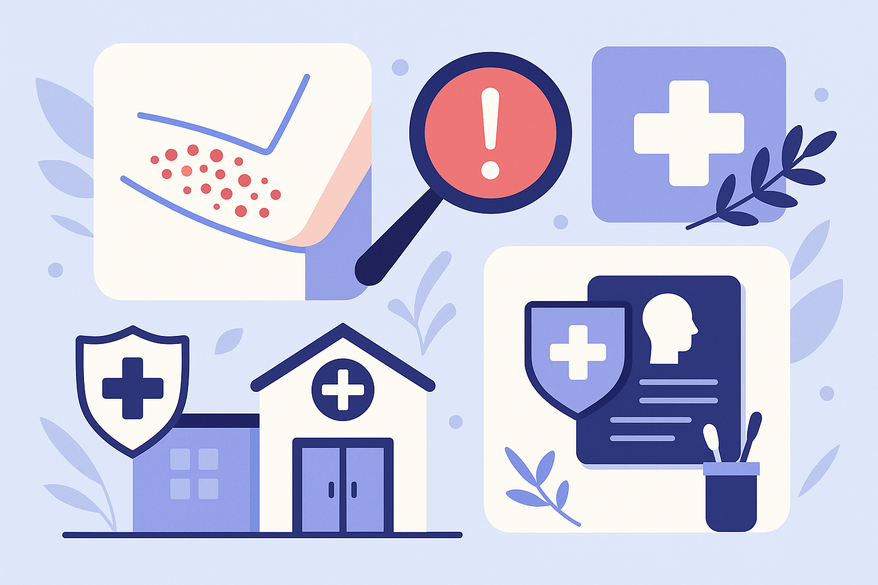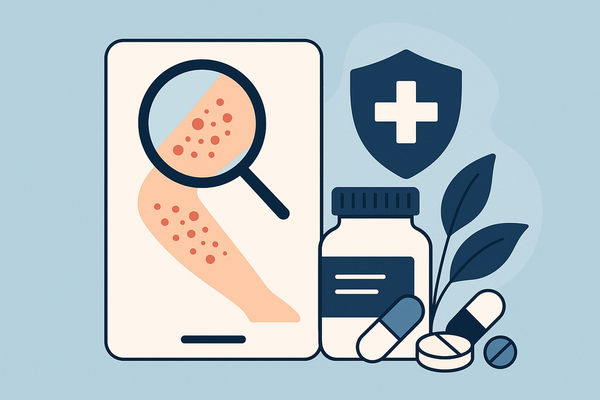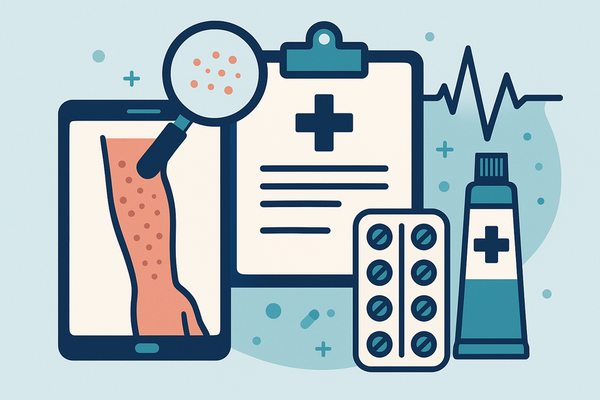Rash Won’t Go Away? Recognize Serious Symptoms & Seek the Right Care
Learn when your rash won't go away, identify serious symptoms, and choose between urgent care and a dermatologist for effective treatment.

Estimated reading time: 7 minutes
Key Takeaways
- Persistent rashes that won’t clear in 2–3 weeks may signal chronic conditions or infections.
- Watch for warning signs like rapid spread, severe pain, blistering, or systemic symptoms (fever, chills).
- Infected rash symptoms include heat, swelling, pus, and red streaks—early treatment is crucial.
- Urgent care vs dermatologist: use urgent care for fast-spreading or systemic issues; see a dermatologist for chronic or unclear rashes.
- Find a dermatologist by verifying credentials, reading reviews, and preparing a thorough rash history.
Table of Contents
- 1. Understanding a Persistent Rash
- 2. Recognizing Serious Rash Symptoms
- 3. Identifying Infected Rash Symptoms
- 4. When and Where to Seek Professional Help
- 5. Finding a Dermatologist Near You
- Rash Detector for Quick Insights
- Conclusion
- FAQ
1. Understanding a Persistent Rash
A persistent rash is any eruption lasting more than 2–3 weeks without major improvement despite home care. These rashes often resist moisturizers, steroid creams, and over-the-counter remedies. Identifying common causes helps you and your provider narrow down the source.
Common causes of persistent rashes:
- Eczema/atopic dermatitis and psoriasis
• Chronic skin inflammation causing red, itchy patches.
• Linked to family history or immune triggers.
Learn how to tell these apart in Eczema vs Psoriasis Rash: How to Differentiate Common Chronic Skin Disorders. - Allergic contact dermatitis
• Rash from chemicals, plants (poison ivy), or medicines.
• Immune reaction when skin encounters an allergen.
Sources: Medical News Today, Mayo Clinic. - Infections (bacterial, viral, fungal, parasitic)
• Microbes invade a broken skin barrier and cause inflammation.
For a deeper dive, see Fungal Rash Symptoms: Your Guide to Skin Infections. - Autoimmune disorders
• The immune system attacks healthy skin cells.
Includes lupus and lichen planus.
Source: Medical News Today. - Repeated exposure to irritants
• Soaps, detergents, and solvents can damage skin.
Sources: UCHealth, Mayo Clinic.
Normal vs abnormal rashes:
- Normal: mild redness with minimal itching, clears within one week.
- Abnormal: persists, enlarges, or spreads beyond the original site.
Understanding these triggers can speed diagnosis and treatment. If your rash won’t go away after a few weeks, consult a professional.
2. Recognizing Serious Rash Symptoms
Some rashes require immediate attention. Key signs a rash is serious include:
- Rapid spread or enlargement
Growth of more than 3 inches in 24 hours could signal severe allergic reactions or infections.
Source: UCHealth. - Severe pain or burning
Intense discomfort beyond itchiness may indicate deep skin damage.
Source: Mayo Clinic. - Blistering, sloughing, or open sores
Skin peeling or large blisters could be Stevens-Johnson syndrome or toxic epidermal necrolysis. - Systemic signs: fever, chills, fatigue
Rash plus high temperature or tiredness often points to infection. - Sensitive-area involvement
Eyes, mouth, genitals, or large areas can risk vision issues, dehydration, or further infection. - Swelling of face, lips, tongue, or difficulty breathing
Signs of anaphylaxis—call 911 immediately.
3. Identifying Infected Rash Symptoms
An infected rash occurs when bacteria or fungi invade through cracks or blisters. Look for these symptoms:
- Increased redness and localized warmth
Skin feels hot and appears deeper red, indicating inflammation from infection. - Swelling and tenderness
The rash area puffs up and hurts to touch. - Pus or yellowish fluid oozing
A sign of bacterial growth under the skin. - Red streaks (lymphangitis)
Lines of red extending away from the rash signal infection spreading through lymph vessels. - Fever or chills
The body’s immune response to fight off microbes.
Compare with non-infectious rashes:
- Eczema/contact dermatitis: itchy, dry, red, no discharge.
- Infected rash: painful, warm, may leak fluid.
If you observe these infected rash symptoms, early treatment with antibiotics or antifungals can prevent deeper infection.
4. When and Where to Seek Professional Help
Choosing the right care setting saves time and improves outcomes. Use this urgent care vs dermatologist guide:
Urgent Care
- Indications:
• High fever with rash
• Rapid spread over hours
• Severe pain or burning
• Signs of infection (pus, red streaks)
• No quick access to a dermatologist appointment - Benefits:
• Walk-in visits
• On-site labs for cultures and blood tests
• Immediate treatments like antibiotic shots or IV fluids
Dermatologist
- Indications:
• Rash lasting more than 3 weeks or recurrent
• Unclear diagnosis after primary care
• Need for advanced diagnostics (biopsy, patch testing)
• Specialized treatments (phototherapy, biologic drugs) - Benefits:
• Board-certified skin experts
• Personalized long-term management
• Access to clinical trials and new therapies
Guideline:
• Rash worsens over hours or systemic symptoms → go to urgent care.
• Rash persists beyond 3 weeks or recurs → book with a dermatologist.
5. Finding a Dermatologist Near You
Follow these steps to find a dermatologist near you:
- Search online: Use “dermatologist near me for rash” on Google, Zocdoc, or Healthgrades.
- Verify credentials: Check board certification via the American Board of Dermatology.
- Read reviews: Look for patient feedback on treatment, communication, and wait times.
- Confirm logistics: Ensure insurance is accepted, hours suit your schedule, and location is convenient.
- Ask for referrals: Request recommendations from your primary care provider.
Prepare for your appointment:
• List rash history: start date, spread, treatments tried.
• Take photos of rash progression.
• Note any triggers, allergies, or family history of skin issues.
Rash Detector for Quick Insights
For an instant, AI-powered preview of potential causes, try Rash Detector. Simply upload photos and receive a sample report in seconds.

Conclusion
Persistent rashes—when your rash won’t go away—can point to chronic skin diseases or infection. Watch for warning signs like rapid spread, severe pain, blistering, fever, and infected rash symptoms. Use urgent care when rashes worsen quickly or you have systemic symptoms. See a dermatologist for chronic, unclear, or recurring rashes. Finally, find a dermatologist near you by checking credentials, reviews, and logistics. Timely care prevents complications and brings relief.
If your rash won’t go away or shows serious or infected symptoms, seek professional evaluation today. Share this guide to help friends and family recognize when to act on persistent rashes and get the right care when it counts.
FAQ
- How long should I wait before seeing a doctor about my rash?
If it persists beyond 2–3 weeks or worsens quickly, seek professional evaluation. - Can a rash spread overnight?
Yes—rapid spread over 24 hours can indicate infection or a severe allergic reaction. - Are over-the-counter creams enough?
They help mild cases, but persistent or serious rashes may require prescription treatments. - Is it safe to use steroids long-term?
Extended steroid use can thin skin; follow a dermatologist’s guidance for long-term management. - How do I know if a rash is infected?
Look for warmth, swelling, pus, red streaks, or systemic symptoms like fever.





